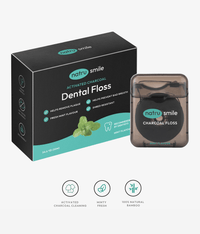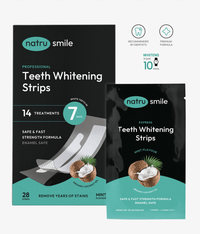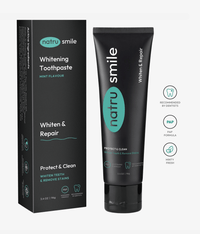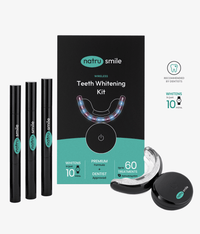
All products are certified by dental expert Dr. Greg Grillo
Receiving a dental filling is an essential procedure aimed at treating cavities and restoring the functionality of your teeth so you enjoy a healthy smile. However, the time immediately following the procedure is quite challenging, particularly when it comes to eating, which is why it's crucial to be adequately informed about post-filling care. In this comprehensive guide for 2023, we will discuss several practical chewing tips to follow after receiving a dental filling, provide insights into possible reasons for discomfort while eating, and offer additional advice on how to maintain the longevity of your filling.
Chewing Tips After A Dental Filling
By following these tips, you will ensure a more comfortable and swift recovery while avoiding any potential complications:
Adhering To Post-Procedure Dietary Guidelines
Your dentist will most likely provide you with specific dietary guidelines to follow after your dental filling procedure. These typically involve avoiding excessively hot or cold foods and beverages, steering clear of sticky or chewy foods, and refraining from consuming hard or crunchy items that may put unnecessary stress on your filled tooth. Following these guidelines will help prevent unnecessary pain and discomfort while allowing your filled tooth to heal optimally.
Chewing On The Opposing Side
In the days following your dental filling, it's advisable to chew primarily with the opposite side of your mouth from the filled tooth. This will allow the filling to set properly while reducing the risk of dislodging or damaging the dental restoration.
Eating Soft Foods
Opt for soft foods that are gentle on your teeth in the post-filling period. Foods like mashed potatoes, oatmeal, yogurt, and soups are typically suitable choices for the first few days following a dental filling. As your recovery progresses and you feel more comfortable, you should reintroduce harder foods into your diet gradually.
Listening To Your Body
It's essential to pay attention to what your body is telling you. If you experience pain or sensitivity while chewing, it could be an indication that you're putting too much pressure on the filled tooth, or that the filling is not properly adjusted. In these cases, reach out to your dentist for an evaluation and possible adjustment of your filling.
Dental Filling Discomfort
Dental filling discomfort may stem from various causes, including post-procedure inflammation, sensitivity, or a high bite. Your dentist will be able to identify the cause of your discomfort and recommend appropriate treatment to alleviate the symptoms. Seeking prompt professional advice is crucial to ensure you maintain a healthy and functional smile.
With the tips provided in this comprehensive guide, you'll be well-equipped to manage any post-filling dietary concerns effectively and maintain a healthy, pain-free smile following your dental filling procedure.
Tooth Pain After A Filling When Chewing: An Overview
A common issue some individuals encounter is tooth pain after receiving a dental filling, particularly when they bite down or consume specific foods. This sensation results from a variety of factors – from the kind of filling used in the restoration, to the procedure itself, or even natural postoperative responses. In any case, it's crucial for anyone who recently underwent a dental filling to fully comprehend the fundamentals of eating after such a treatment. This understanding helps minimize discomfort, eliminate potential complications, and guarantee a swift healing process.
Factors Contributing To Tooth Pain After A Filling
To better understand the cause of tooth pain after a filling, let's examine the following factors in more detail:
-
Type of Filling Material: Different filling materials cause varying sensations and reactions in your mouth. For instance, amalgam (silver) fillings might cause sensitivity to hot and cold foods due to their thermally conductive nature. Whereas, composite (tooth-colored) fillings may not have the same thermal sensitivity, but could cause discomfort due to bonding with the tooth structure.
-
The Procedure Itself: During a filling procedure, your dentist may need to remove decayed or damaged tooth structure. This process could potentially irritate the tooth's nerves and cause pain when biting down. Additionally, the injection site for local anesthesia might also be sore after the procedure, leading to discomfort when applying pressure on the affected area.
- Normal Postoperative Reactions: It's not uncommon for patients to experience some degree of pain and sensitivity immediately after a dental filling. These sensations typically subside within a few days as your mouth adjusts to the new filling.
Tips For Eating After A Dental Filling
To ensure you don’t experience unnecessary pain or complications after a dental filling, take note of these helpful tips:
-
Avoid Hard or Crunchy Foods: Consuming hard or crunchy items puts undue pressure on a recently filled tooth, leading to increased pain or even damage to the new restoration. Opt for softer foods during the initial recovery period.
-
Steer Clear of Hot and Cold Foods or Beverages: Extreme temperatures exacerbate tooth sensitivity, especially after receiving a fresh filling. It's best to avoid very hot or cold consumables until the tooth completely adjusts to its new state.
- Chew on the Opposite Side: To reduce discomfort, try chewing on the opposite side of your mouth from the filling. This will minimize pressure on the recently filled tooth and help alleviate any pain you might experience.
With these factors in mind, you'll be better equipped to handle tooth pain after a dental filling and ensure a smooth and seamless recovery process.
Chewing Tips To Remember After A Dental Filling
After undergoing a dental filling procedure, it's essential to take the necessary precautions to ensure a smooth healing process and to avoid doing anything that may jeopardize the success of the treatment. With that being said, let's look at some valuable chewing tips to keep in mind as you resume eating after receiving a dental filling:
Avoid Hard Or Crunchy Foods
One of the first things to be mindful of is to stay away from hard, crunchy foods like popcorn, nuts, and apples. These types of foods exert significant pressure on your recently-filled teeth, which may result in pain or even damage the filling itself. For optimal recovery, you should avoid these foods for at least 24-48 hours after the procedure. Instead, opt for softer foods like mashed potatoes, yogurt, or pasta during this time, as they are more gentle on your teeth.
Chew Slowly, Bite Lightly
Another important tip to remember is to take your time when chewing food and to do so gently. Making an effort to chew slowly and lightly bite down on food allows for a more controlled and cautious chewing motion that ultimately minimizes the risk of complications or discomfort. This habit will allow your filled tooth to heal properly while reducing unnecessary stress on the area.
Keep Your Mouth Closed
While it may not be the first thing that comes to mind, keeping your mouth closed during the chewing process is a useful tip to follow. Breathing through your mouth while chewing exposes your teeth to cold air, potentially making your teeth more sensitive after a filling. To circumvent unnecessary pain or sensitivity, aim to breathe through your nose and ensure your mouth remains closed while chewing food.
Avoid Excessive Sweets
It's less than ideal to indulge in sweets and sugary treats after receiving a dental filling. Despite the temptation, it's important to remember that consuming excessive sugar leads to tooth decay - which is the very issue a dental filling is meant to address.
To maintain good oral health and prevent further decay, it's essential to keep your sugar intake in check, opt for more nutritious options, and continue practicing good dental hygiene. You should also be spacing out your meals and avoiding excessive snacking - each time a person consumes sugar, bacteria break down the sugar to produce acid, which is present in your mouth for 20 to 40 minutes after eating. If sustained for too long, and too often, this acid causes tooth decay, which will just create another filling.
By following these helpful chewing tips after a dental filling, you'll be on your way to optimal dental health and a speedy recovery. Remember to always consult with your dental professional if you have any concerns or experience any issues following your dental filling procedure.
Other Possible Reasons That Can Affect Eating After A Filling
While most people experience little to no discomfort after a filling procedure, some may have postoperative symptoms. Here are a few possible reasons that affect eating after a dental filling, along with explanations to help you better understand what you may be going through.
Local Anesthetic
During most dental filling procedures, local anesthesia is applied to numb the area being treated. This ensures that you're comfortable and feel minimal pain during the procedure. However, the effects of the local anesthetic linger for a few hours after the actual procedure, creating a numb sensation in the affected area. Consequently, you might find it challenging to eat or drink until the anesthesia fully wears off. If you continue to experience numbness after a few hours, it's wise to consult your dentist for guidance and further evaluation.
Postoperative Discomfort
It's not uncommon to experience mild pain, discomfort, or even swelling after a dental filling procedure. While this is bothersome, over-the-counter pain medications typically provide relief. However, before taking any medication, always talk to your dentist about the best course of action based on your individual situation and dental history.
Heightened Sensitivity
In some cases, teeth may become more sensitive after dental fillings. This makes it uncomfortable or even painful to eat foods and drinks at extreme temperatures following the procedure, whether hot or cold. Generally, this sensitivity should subside after a few days. However, if the increased sensitivity persists, contact your dentist to discuss your concerns and receive professional advice.
Gum Tissue Discomfort
During a dental filling procedure, the surrounding gum tissues may become irritated or inflamed, which consequently leads to discomfort when chewing near the affected area. To alleviate this discomfort, you should utilize ice packs and take over-the-counter pain medication, as directed by your dentist. Following their guidance will support a smooth recovery process and help to minimize any discomfort you may be experiencing.
Different Bite
After a filling procedure, your bite may feel different due to the new dental material and changes to your tooth's structure. As a result, you may experience discomfort or unease while chewing until your mouth becomes accustomed to the altered configuration. If this issue persists for more than a week, it's essential to consult your dentist to ensure that the problem is adequately addressed and resolved.
In conclusion, several factors influence your ability to eat comfortably after a dental filling. If you experience any persistent discomfort or notice unusual changes in your mouth, don't hesitate to reach out to your dental professional for assistance. They are equipped to handle these situations and provide expert guidance to ensure your oral health is well taken care of.
How Long After A Filling Procedure Should You Wait To Eat?
The recommended wait time before eating after a filling procedure varies depending on several factors, such as the type of filling material used, how quickly you recover, and any potential complications that may arise. While some dentists may suggest waiting approximately two hours, it is crucial to heed your dentist's specific advice for your unique situation.
Factors To Consider
-
Filling Material Type: Different types of filling materials, such as amalgam, composite, glass ionomer, or gold inlay, may have different hardening times and therefore affect how long you should wait before eating.
-
Individual Recovery Time: Each person's body responds differently to dental procedures, and some may require a longer wait time before eating to avoid disrupting the filling.
- Potential Complications: If your dentist is concerned about the risks of complications, they may advise a longer wait time before eating.
Ultimately, it's essential to ensure the local anesthesia has completely worn off before eating to avoid accidentally biting your tongue or inner cheek.
How Long Should Fillings Hurt When Chewing?
Mild discomfort after a filling procedure is not uncommon and usually resolves itself within a few days. However, if you find that you're experiencing persistent pain or discomfort when chewing beyond one week following the procedure, this could be indicative of a problem either with your filling or another dental issue that needs attention.
When To Consult Your Dentist
If your pain during chewing continues or worsens, it is essential to consult your dentist as soon as possible. They will help determine the root cause of the issue, such as an improperly placed filling, sensitivity to the filling material, or an unrelated dental problem, and offer a suitable solution.
Can I Whiten My Teeth After Getting A Filling?
Many people who receive a filling want to whiten their teeth afterward, especially because metal fillings often cause discoloration over time. The answer depends on several factors such as the type of material used for your filling, the color of your teeth, and how long you have had the dental fillings.
If you have a metal filling, such as gold or silver amalgam, whitening your teeth is impossible. These types of fillings are made with metal particles that do not respond well to bleaching products and are discolored even more. Your dentist will likely recommend replacing the metal filling with a composite or porcelain one that are matched to the color of your teeth to make them look as natural as possible.
If you have a tooth-colored filling such as composite or porcelain, you may be able to whiten your teeth after receiving the dental work by using a professional whitening system at home. However, there are some things you should consider before doing so.
The first is that the bleaching products may not be able to penetrate the filling material, which means it won’t have any effect on your teeth. In addition, the bleaching agent causes some of the filling material to dissolve or become weakened over time, leaving you with a weak tooth structure and an unattractive appearance.
It is important to talk to your dentist about teeth whitening after dental filling. They can give you advice on whether or not it is safe for you and how best to go about it without damaging your dental work. Your dentist may also suggest other treatments such as a professional whitening system or veneers that help give your teeth the desired look.
What Is A Temporary Filling?
A temporary filling is a dental restoration material used to fill cavities in teeth. It’s not intended to be a permanent solution and should only be used as an interim measure until the dentist applies more permanent materials such as porcelain crowns or bridges.
Temporary fillings are made from materials like zinc oxide-eugenol, calcium hydroxide, glass ionomer cement, composite resin, and silver amalgam. These substances are chosen for their ability to seal off the cavity while allowing enough flexibility that it won’t crack or chip when chewing hard food items.
My Filling Fell Out. What Should I Do?
Losing a dental filling is an unexpected and often stressful event that cause discomfort and potential damage to your teeth. Fortunately, there are steps that you can take to address the situation and protect yourself from further complications.
It’s important to identify why your filling fell out in the first place, as there are many potential causes that would make a filling fall out. In some cases, fillings may fall out due to normal wear-and-tear or age; however, if your tooth was recently filled or the filling was damaged, it may be a sign of an underlying issue.
If the root cause is unclear, it’s best to go and see your dentist as soon as possible. A full evaluation will help them determine if further treatments or actions are needed to protect your teeth from decay or other complications. If the filling fell out due to normal wear-and-tear, then they can replace it with a new one that should last for several years. In some cases, however, your dentist may suggest an alternative treatment such as a dental crown or veneer instead of replacing the filling. Dental crowns and veneers are made from porcelain or ceramic, and they provide a more secure coverage for the tooth which helps prevent further damage.
In the meantime, there are ways to protect your teeth from decay or infection until you get to see your dentist. Make sure that you brush and floss as usual; however, be careful around the empty filling area so as not to cause further damage or discomfort. You should also avoid eating any sticky foods such as candy or chewing gum since these easily become stuck in the gap left by your missing filling.
If you are experiencing any pain or discomfort, taking an over-the-counter pain reliever helps. However, it’s important to remember that these medications should not be used as a long-term solution and should only be taken until you get to your dentist for further treatment.
The Bottom Line
Proper care and attention to your teeth after a dental filling are critical for promoting healing and preventing complications. By adhering to our detailed guide to a dental filling and discussing any concerns with your dentist, you'll be well on your way to a smooth recovery and returning to enjoying your favorite meals without worry. And don't forget - scheduling regular dental check-ups is crucial for maintaining your dental health and catching any potential issues before they become serious.










